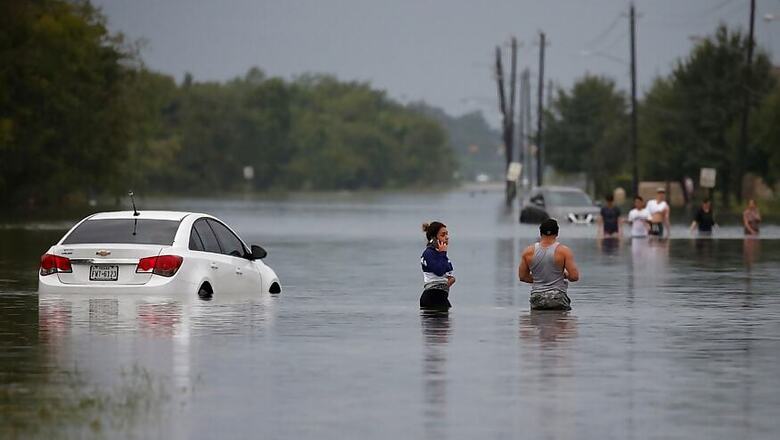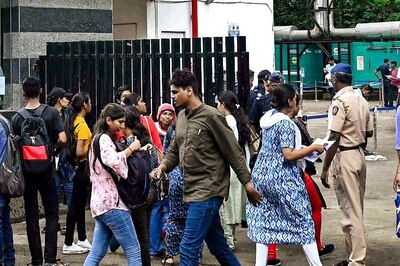
views
Port Arthur, Texas: Soldiers and police in helicopters and high-water trucks rescued thousands of Texans stranded by floodwater from Hurricane Harvey on Thursday, which has killed dozens of people and displaced more than a million others as it drenches the Gulf Coast.
Some 779,000 Texans have been ordered to evacuate their homes and another 980,000 fled voluntarily amid concerns that swollen reservoirs and rivers could bring new flooding, according to Department of Homeland Security acting Secretary Elaine Duke.
Harvey roared ashore late Friday as the most powerful hurricane to hit Texas in a half-century. It has since been downgraded to a tropical depression as it heads inland, leaving devastation across the southeast corner of the state.
Jessica Richard, 24, said she waited out the storm in her home in Port Arthur, about 85 miles (137 km) east of Houston, until Thursday morning when water on her street rose to waist-depth. She was picked up by a passing truck.
"All my family is safe even though there were a few close calls," said Richard, adding that her nephew had been trapped overnight in a flooded apartment with several family members. "He said there were snakes in the water and spiders crawling up the walls. But they got out."
At least 38 people were dead or feared dead in six counties including and around Houston, according to local officials.
In the U.S. energy hub of Houston, which was paralysed by the storm earlier in the week, firefighters conducted a block-by-block search of homes to rescue stranded survivors and recover bodies.
ORANGE COUNTY EVACUATION
In Beaumont, Texas, about 80 miles (129 km) east of Houston, doctors and nurses evacuated some 190 people from a hospital that halted operations after the storm knocked out water service in the city of almost 120,000 people.
Orange County, which borders Beaumont, on Thursday ordered remaining residents to evacuate the area amid a forecast that the Neches River would crest on Friday, threatening homes.
Just east of Rose City, Texas, a line of cars and trucks were pushing through water flowing over the Interstate highway.
A convoy of civilian volunteers from the ad-hoc "Cajun Navy," who have been carrying out rescues all week, waited as their leader, Phil Drager, negotiated with police to stop traffic and launch an airboat for a scouting mission.
"Now I can add shutting a major Interstate highway to my resume," Drager said.
U.S. Vice President Mike Pence visited Texas on Thursday, touring the coastal city of Rockport, where Harvey slammed ashore onto the mainland late Friday.
"The American people are with you. We are here today, we will be here tomorrow and we will be here every day until this city and this state and this region rebuild bigger and better than ever before," Pence told a crowd outside a Rockport church damaged by the storm.
POWER STILL OUT
Gasoline futures soared more than 13 percent on Thursday, as almost a quarter of U.S. refining capacity had been knocked offline by the storm, raising fears of fuel shortages.
About 189,000 homes and businesses remained without power.
Moody's Analytics estimated the economic cost from Harvey for southeastern Texas at $51 billion to $75 billion, ranking it among the costliest storms in American history.
The event has drawn comparisons to 2005's Hurricane Katrina, which killed more than 1,800 people in New Orleans. Then-President George W. Bush's administration was widely criticized for the haphazard initial response to that storm, and the Trump administration was taking care to be seen as responding quickly to the first major natural disaster it has faced.
President Donald Trump was to return to the region on Saturday.
Early Thursday, explosions could be heard at a chemical plant in Crosby, Texas, owned by Arkema SA. Refrigeration systems failed in a truck storing volatile chemicals, which ignited as they warmed, sending smoke plumes 40-feet (12-meters) into the air, according to company and public safety officials.
After the blasts, local and federal public safety officials, and company representatives insisted there was no risk to the public outside the 1.5-mile (2.4-km) safety perimeter, even though they said eight more trucks storing the same chemicals would eventually catch fire.
HOUSTON SURVEYS DAMAGE
Some signs of normal life returned to Houston, the nation's fourth most populous city.
Residents began a massive cleanup, dragging water-logged furniture to the curb, hunting for supplies and repair estimates. The city began limited trash pickup and bus services. Hospitals that had struggled to stay open earlier in the week were phasing in clinical operations.
Most of Houston’s larger companies said they would remain closed through the Labor Day holiday on Monday, but employees of smaller businesses and offices were trekking back to work.
Both of the city’s major airports were operating on Thursday and traffic returned to its notoriously clogged highways. The start of public school was delayed until September 11.
Anita Williams, 52, was lined up at a shelter at Houston's George R. Brown Convention Center to register for aid from the Federal Emergency Management Agency. Williams had returned home on Wednesday to survey the damage to her one-story house.
"It's not my house anymore," Williams said. "My deep freezer was in my living room."



















Comments
0 comment